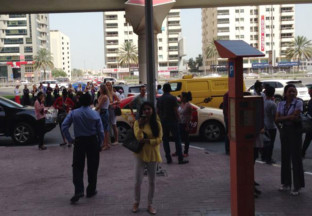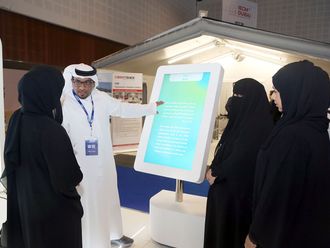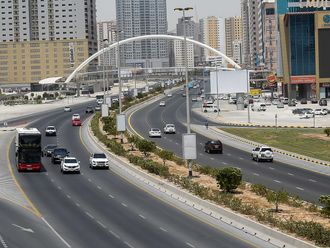
Al Ain: Tremors hit UAE on Tuesday morning at 9.44am after a 5.1 magnitude earthquake struck Iran’s Qeshm Island located some 120km north of Ras Al Khaimah in the Arabian Gulf.
The epicentre of the quake, which occurred 10km deep in the earth, was in the coastal area of Qeshm where some five different-intensity earthquakes struck yesterday. “It’s an earthquake-prone area where light to moderate quakes are routine happenings,” said a seismologist.
The National Centre of Meteorology and Seismology (NCMS) confirmed the tremors, saying they were felt deep in UAE’s northern emirates, Dubai, Abu Dhabi, Al Ain, Fujairah, and up to Madinat Zayed in the Western Region of Abu Dhabi emirate. The tremors were, however, weak and caused no damage anywhere or casualties in the country.
Many people became panicky, especially those living or working in high-rise buildings in Dubai and other coastal cities. They evacuated buildings and gathered in nearby open spaces, car parking lots, and parks. Social media also buzzed with the reports of tremors that were felt just for few seconds.
“It was a terrifying experience,” said John Augustine, a resident of Dubai. He said he was in his office located on the 10th floor of a downtown building when everything around him started shaking. “I quickly realised it was a quake and rushed out of the building along with my colleagues.”
Mohsin Ahmad, a resident of Abu Dhabi, said he was inside the elevator of his office building when the tremors hit. “I was already going out but the strange cracking sounds coming out of the dangling lift terrified me,” he said.
Ahmad said he saw many people standing in open areas around buildings.
Abdul Jabbar, a resident of Al Ain, said he also experienced the tremors but they were very light. “I believe people hardly noticed the quake in the oasis city,” he said.
Dr Abdul Kareem, a seismologist, said people often get unnerved and run out of buildings in panic in case of an earthquake. “That’s potentially dangerous behaviour, capable of causing injuries to the person and the people around him,” he said.
He advised people to stay calm instead of reacting uncontrollably. In case of evacuation, said Dr Abdul Kareem, people must do it orderly, calmly and only when things stop shaking around them. People must follow safety and security guidelines to avoid injuries.
UAE cities often experience mild to moderate intensity tremors, mainly from earthquakes hitting Iran and Pakistan. Dibba, Fujairah, Ras Al Khaimah and parts of the eastern emirates have experienced jolts in the past. According to geologists, limited seismic activity also takes place at the three UAE’s local fault zones that are located in the vicinity of Dibba, between Bidiya and Jebel Salhal, and Wadi Ham.
Iran has one of the most active major fault zones and UAE’s close proximity to it is a source of concern. Iran has a history of earthquakes and a major fault line passes through its Zagros belt in the southern area. In this region, the Arabian tectonic plate has been pushing against the Eurasian plate at a rate of approximately 3cm per year.
Unlike the Western Region, the northern emirates have experienced earthquakes several times since March 1999. The last earthquake in the UAE was felt in April when a powerful 7.8 magnitude earthquake hit Pakistan’s southwestern region.
According to the Dubai Municipality Seismic Network, tremors felt in Dubai and other parts of the country caused by the earthquake in southern Iran to the south of Qeshm Island had no special effect in the region.
The network recorded the main shock at 9.44am today with a magnitude of 5.8 on the Richter scale.
While the 5.8 tremor had a stronger impact only in Ras Al Khaimah, people who were in high-rise buildings of Dubai felt it and were forced to get out of them.
Eng Mohammad Mashroum, director of survey department, Dubai Municipality, said these seismic activities happened in the seismic belt that extends north-west parallel to the Zagros mountain belt because of the collision of the Arabian and Eurasian tectonic plates.
He also confirmed that all buildings in Dubai are safe against such moderate tremors.
Abdul Ellah Man’a, a government employee, said that he was felt everything around him shaking for a few seconds and then everything returned to normal.
While Saeed Al Dhuhri, a resident of Al Shaml area, told Gulf News that he was sitting on a chair when he felt the chair shaking. “It felt like someone was pushing me and attempting to pull my chair away from me,” he said.
“It is the first time in my life I felt the tremors. I had only heard about these from people but this time I felt it,“ he said.
However, Ahmad Al Shehi, a resident from Al Rahba area, said that he did not feel anything. “We live in a mountainous area and we felt nothing,” he said.
An Indian manager in Dubai said “a lot of people” from a number of towers on Shaikh Zayed Road could be seen outside buildings soon after the tremors.
“I felt the floor shake and, when we got up from our seats, it shook again. Our office staff rushed down. My legs are numb from walking down almost 30 flights of stairs,” said the 29-year-old.
Workers also evacuated offices in Hamarain Centre in Deira, according to a Pakistani senior executive there. “People are still waiting outside because they think there may be aftershocks,” he told Gulf News.
The National Emergency Crisis and Disaster Management Authority declined to comment for the time-being leaving the matter to the UAE’s National Centre for Meteorology and Seismology.
The latter confirmed Iran 5.1-magnitude earthquake and said it was felt in Dubai and the northern emirates but caused no damages.
—With inputs from Samir Salama, Associate Editor; Mariam M. Al Serkal, Senior Reporter; Faisal Masudi and Aghaddir Ali, Staff Reporters












